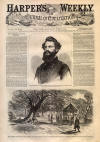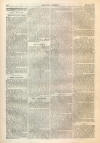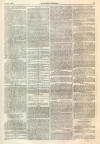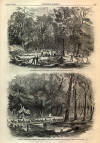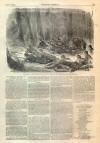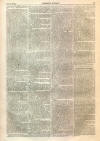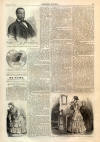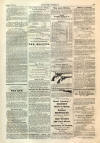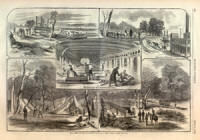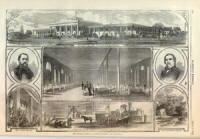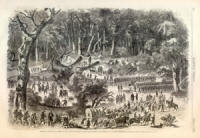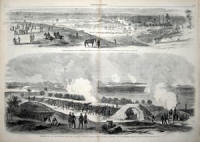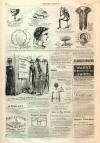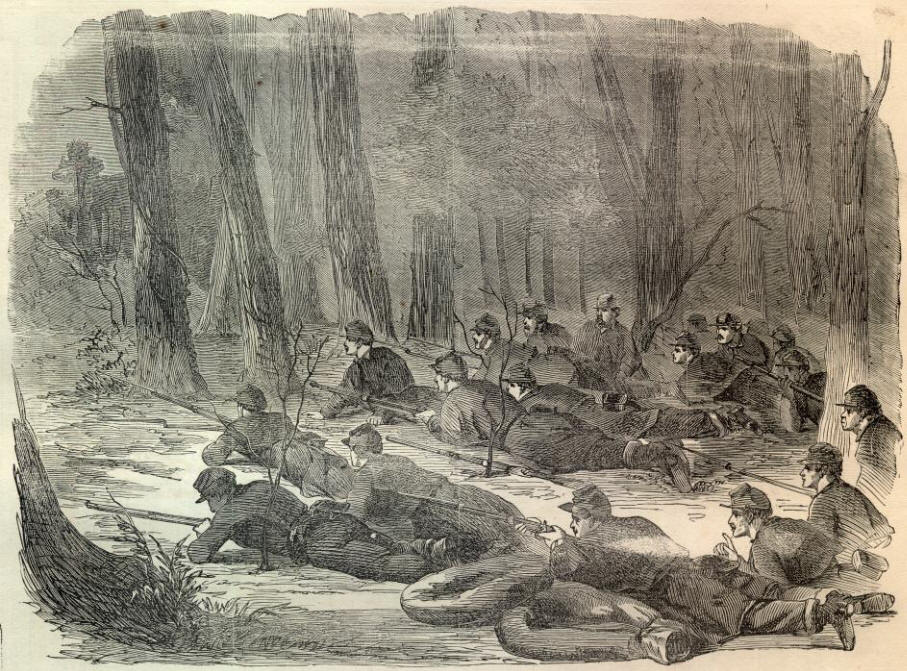|
This Site:
Civil War
Civil War Overview
Civil War 1861
Civil War 1862
Civil War 1863
Civil War 1864
Civil War 1865
Civil War Battles
Confederate Generals
Union Generals
Confederate History
Robert E. Lee
Civil War Medicine
Lincoln Assassination
Slavery
Site Search
Civil War Links
Civil War Art
Mexican War
Republic of Texas
Indians
Winslow Homer
Thomas Nast
Mathew Brady
Western Art
Civil War Gifts
Robert E. Lee Portrait
|
THE
GENERAL HOSPITAL AT
FORTRESS MONROE.
OUR special artist at Fortress
Monroe sends us a page of sketches of the
GENERAL HOSPITAL at that place. The upper
sketch gives an extensive view of the building, which is the Hygeia Hotel, so
celebrated and frequented only a short time ago. Mr. C. C. Willard, the
proprietor, has given up the whole building excepting a very few rooms at one
end for the purposes of the Hospital. The middle sketch is the immense
dining-room of the hotel, now used as the surgical ward. Dr. John M. Cuyler,
medical director of the Department of Virginia, is represented on the right, and
Dr. R. B. Bontecou, who is in charge of this hospital, on the left of the
picture. In the lower corners are shown the pleasant front portico of the
building, a favorite lounging place for the convalescent, and to the left a
soldier's grave. We have also a scene on the dock at the time of the arrival of
a large number of wounded men from Ship Point.
GENERAL HALLECK'S ARMY.
WE publish on pages 356 and 357
several pictures which illustrate the state of affairs in the Army of the
Southwest, under
General Halleck. They are from sketches by our
artists, Messrs. Mosier and Simplot. The following bits from the World
correspondence may serve to shed some light on the subjects of the pictures:
THE COUNTRY ROUND CORINTH.
The country around Corinth is of
a rolling timbered land, sweeping in successive ridges and flat boggy hollows
for miles in every direction. These latter make it a matter of difficulty to
approach the place with artillery. The rebels have embraced a circuit of hills
several miles in which they are encamped. The length of these works is estimated
at nine miles, and they are reported to have several heavy siege pieces in
position at the salient points. There is first an abatis of felled timber a mile
from the guns, which, while it will present an obstacle to the passage of our
lines, will present an admirable cover for our sharp-shooters. Beyond the timber
is a rifle-trench, at a few hundred yards distance from the guns. Behind this
breast-work it is thought the enemy's forces will be lodged after the place is
invested. The inner line is a series of angles and bastions running from
hill-top to hill-top, a heavy gun being placed to command every approach.
PREPARED FOR DISASTER.
That we may be prepared for any
untoward occurrence, such as a stampede, a reverse, or an attempt on the part of
the rebels to pierce our lines, our men have been engaged busily yesterday and
to-day in erecting a strong line of breast-works formed of timber and branches
covered with dirt, which are again masked so as to conceal them from the view of
the enemy. The most commanding positions have been seized, the first line about
eight miles from Corinth.
With a cleared space in front and guns placed in commanding positions the enemy
can not approach our line without being subjected to a murderous fire.
THE ROADS—MUD AND DUST.
But a few days since the mud was
the great impediment to our progress. We are now at the other extreme. So far
from being troubled with too much moisture, we have
not enough to drink, much less
for other purposes. Our men are digging for water, and the result is, a thick,
whitish mixture of nauseous taste is all that can be had potable. Horses are
ridden a mile to a muddy, stagnant pool, and not unfrequently the soldiers are
reduced to the same extremity. Lemons and liquors are in great demand to render
the water palatable.
HOSPITALS.
The hospital arrangements are
proceeding on the scale commensurate with the expectations of a great battle. A
large general hospital has been established at Monterey, in charge of the
accomplished brigade surgeon, R. C. Metcalfe, of the Seventh Illinois, who is
busy making ample arrangements for the reception of a great number of sufferers.
Seven hundred tents, litters, stretchers, ambulances, medicines, and sanitary
stores, are being collected in quantities, with a large medical staff. A
competent farce of the older surgeons, who have been under fire, will accompany
the forces to the field, and there, doubtless, save many lives which might be
lost by an hour's neglect. The most ample arrangements have been made for
obtaining the names of the sufferers in the anticipated battle, and if the
friends of such are disappointed, they must attribute the causes not to any want
of attention on the part of journalists, but to the officers of the army, who
are bound, like dull scholars, within the volume of army regulations, to the
very great inconvenience of an anxious public.
MOVING FORWARD.
Tuesday, May 13.
The cry is still we come, O
Corinth! We went back, picked up bag and baggage, swept off leftward, and now
occupy a superb spot for camping four miles in direct line from Corinth. The
swamp in front is an immense one; they can not cross it, or we, with artillery,
except by the great corduroy highway that we have built—a thundering piece of
architecture. Could hardly believe my eyes yesterday as I sauntered to the right
of it. We occupy Farmington—pickets just beyond it. Rebel pickets and ours a
half mile apart.
General Buell's batteries have
seen probably less service than any others, but they contain some very superior
guns; among them we saw the long Rodman guns, calculated to throw shells at
least three miles. Besides these, the five heavy siege guns, which were of so
much use in staying the advance of the rebels at Pittsburg, commanded by Captain
Madison, have been moved forward by a team composed of six yokes of oxen
attached to each.
THE ARMY OF THE POTOMAC.
WE reproduce, on pages 353,
360,
and 361, several sketches by our artist, Mr. A. R. Waud, illustrating the
fortunes of the Army of the Potomac. One of them shows us THE UNION TROOPS GOING
DOWN INTO THE TRENCHES WITH THEIR SHOVELS TO CONSTRUCT PARALLELS BEFORE
YORKTOWN.
McClellan, as
General Scott has told us, is at home in the work of
"trenching." He did so well at it that in one month he had pushed his parallels
against
Yorktown as far forward as the Allies pushed theirs before Sebastopol
after eleven months labor. When the rebels "skedaddled" the last parallel was
almost completed, and the assault was at hand.
Another picture shows us the
famous BATTERY No. 1, composed of one and two hundred pound Parrott guns, the
effect of whose practice scared the rebels so thoroughly. On the morning of 2d
May this battery opened on a rebel battery situated on the heights of Yorktown,
and very quickly
silenced it. The-rebels had never
seen any thing like the 200-pounder projectiles from the Parrott gun, and asked
their officers indignantly "if they were expected to stand such shots as that?"
A third picture shows us the
ENCAMPMENT OF THE ARMY OF THE POTOMAC at Cumberland, on the Pamunky River. It is
a beautiful scene. A correspondent thus describes the agreeable surprise of our
wearied troops as they approached it on their march from Williamsburg:
Just as I was preparing to give
up the ghost from sheer exhaustion, and the troops were trudging along under
their packs of baggage, beneath a scorching sun and amidst clouds of dust, which
at times threatened to put an end to the march by destroying our powers of
respiration, we reached the brow of a hill, and below us, upon a plain upon the
banks of the river, lay spread before us a sight as beautiful as it was warlike.
Two brigades lay in the field upon their arms, and long trains of wagons were
finding their way along the serpentine road to the camp ground, and a perfect
fleet of shipping lay moored in the stream, where twenty-four hours since
floated the "rag of Secessia." The gun-boats had opened the way, and thus
enabled our grand army to receive supplies which would have taken weeks to
transport by land.
Another correspondent says:
The scenery all along the Pamunky,
from its junction with the York River to the point to which the gun-boats
ascended, is magnificent. Indeed I have seldom, if ever, seen any thing to equal
it. The banks are usually high. In some places, quite frequently, too, these
banks form bluffs from fifty to one hundred feet high. In others they slope
gradually down to the water's edge. The river is comparatively narrow, yet wide
enough and deep enough for the passage of any of our vessels. Its banks are
beautified with innumerable cottages and buildings of more ambitious
pretensions, each one surrounded by lawns and grounds beautifully laid out, and
each one, doubtless, inhabited by people of comparative refinement, who must
have sense enough to deplore the infatuation which has brought the scourge of
war to their doors.
All along the banks of the river
were seen herds of cattle and sheep, which had been collected by the rebels and
driven thus far in their retreat from Yorktown.
The results of reconnoissances
show that the road and water approaches to Richmond are open to within twelve or
fifteen miles of that city, and that the enemy is in force beyond those points.
The state of the roads is such that it will require some days to get the army up
to those points. Ever since last Monday, now a week ago, the army has been
moving from the neighborhood of West Point to this place, a distance of only
about twenty miles. Yet steady progress has been made on each day. The nature of
the soil is such that it is found necessary to construct military roads nearly
the entire distance in order to transport the artillery and baggage-wagons. This
work has been admirably performed by the engineer corps of General Daniel P.
Woodbury, whose labors have been incessant. There are some spots in the roads,
over swamps and ravines, where a mile a day is considered good progress. Let
those who feel impatient at our slow progress toward Richmond remember this and
be content.
On
page 365 we give a fac-simile
of the CROSS-BELT PLATE of a private of the Massachusetts First indented by a Minie ball at the battle of Williamsburg. The ball penetrated the plate, but did
not go through it, fortunately for the soldier.
BRIGADIER-GENERAL GEORGE STONEMAN,
whose portrait we publish on
page 353, was born in this State in the year 1825.
He graduated at West Point in July, 1846, and entered the First Dragoons as
Second Lieutenant. He rose steadily in his profession, and when the war broke
out was Captain. The resignation of Southern traitors facilitated his
advancement, and in May, 1861, he became Major of the Fourth Cavalry. General
McClellan realized his merit, and in September, 1861, he was appointed
Brigadier-General of Volunteers, and given the command of all the cavalry of the
Army of the Potomac. In the advance upon Richmond from Yorktown he has commanded
the vanguard of the army, and conducted his column with judgment and vigor.
General Stoneman married last
year a Baltimore belle.
On this page we reproduce a
sketch by our artist, Mr. Homer, showing one of our OUTLYING PICKETS ON A DARK
NIGHT; and on page 361 we publish a vivid picture from a sketch by Mr. Meyer,
showing THE MARCH OF OUR ARMY THROUGH MUD AND THICKET FROM WILLIAMSBURG TOWARD
CUMBERLAND. Both these pictures explain themselves.
LOVE VERSUS BEAUTY.
VERDICT FOR THE PLAINTIFF.
LOVE, perched one day On an
orange-spray, Saw Beauty whiling The time away,
In a bower of his own red roses,
"Ah!" chuckles he, "Here's work
for me!"
As he flies where the maid
reposes.
"How dare you stare,"
Quoth the lady fair,
"Strutting, and bridling,
And ogling there?
None of your pranks on me!
I'm up to your tricks and your
plots, Sir, now! And I won't believe your strongest vow,
So let by-gones by-gones be."
"Oh!" whimpered he, "But you used
to be To my sacred rites Such a devotee,
To all my lures a friend." "Well,
well," said she; "Yes, that may be,
But it's 'never too late to
mend.'"
Then aloft he flew,
And his bright bow drew,
And the silver arrow
Went whistling true
To the roguish maiden's breast;
While she, blushing, laughed,
with a well-feigned sigh, "Come, it's no use fighting with Destiny,
And 'second thoughts are best!'"
|
